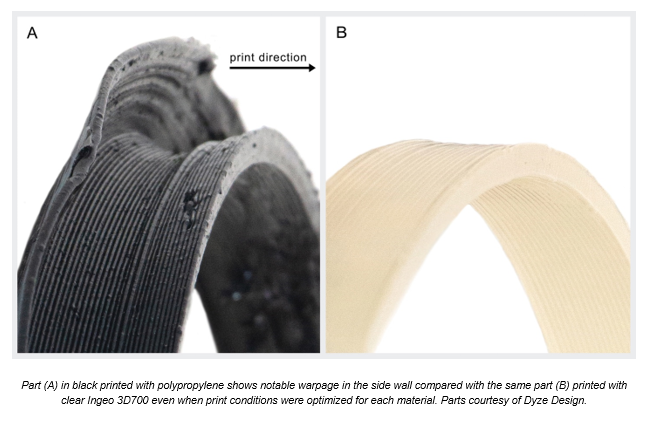Materials company NatureWorks has added a new filament its portfolio of Ingeo™️ biopolymers specially designed for additive manufacturing. Named Ingeo 3D700, the new filament is a PLA grade material for large-format additive manufacturing.
What’s interesting in NatureWorks’ materials development is that the producer’s materials constitute a broad portfolio of renewably sourced polymers and chemicals.
The company explains that in general, monofilaments made with Ingeo biopolymer PLA are mostly used with desktop 3D printer. Therefore, they provide characteristics such as precise detail, good adhesion to build plates with no heating needed, reduced warping or curling, and low odor while printing. These properties make Ingeo well-suited for 3D printing using many different types of printers and for a broad range of printing applications from consumer-level to industrial applications.
The thing is large-format additive manufacturing does not deliver the same performance. Due to the higher rate and volume of polymer deposition, operators might experience excessive warpage with certain materials, like ABS, or significant shrinkage as with some polyolefins or even some general-purpose PLA grades.
This can result in failed prints as warping pulls the part away from the print bed or causes layer separation. With the longer print times and higher-volume material use in industrial applications, failure during production is costly. By controlling the polymer-microstructure, the resulting amorphous PLA grade, Ingeo 3D700, has a low material shrink rate which is critical for reducing warpage, improving gap fill and adhesion, and ensuring successful prints.
“As the 3D printing space expands into larger, more complex applications, we are seeing an increased need for printing materials that are tailored for a specific application or process,” says Dan Sawyer, Business Development Leader for NatureWorks. “With significant growth in large-format additive manufacturing for industrial applications, we saw the opportunity to develop a new Ingeo biopolymer grade specifically designed to minimize the loss of time and material due to failures in large format prints.”
A common approach for minimizing part warpage in large prints is to use compounded materials with reinforcement such as mineral fillers, glass, carbon, or cellulosic fiber. Because Ingeo 3D700 has been designed for low shrinkage, there is an opportunity to use less reinforcing product and still achieve quality large-format parts, while maintaining the reliable printability of Ingeo PLA. If a specialty print requires additional reinforcement, then cellulose-based additives are easily compounded with Ingeo 3D700 creating a biobased compound alternative to high-cost petrochemical-based compounds such as carbon-fiber ABS.
Following several testing for use in large-format fused filament fabrication (FFF) and direct resin-to-print processes, different results have been observed:
Filament manufacturer, MCPP, conducted printing tests using filament made from Ingeo 3D700 and demonstrated a 11-13% increase in flow rate due to the optimized melt viscosity, compared to a general-purpose PLA. According to MCPP, “this resulted in improved gap fill and adhesion between perimeter layers. Therefore, it is also expected to be suitable for FGF (fused granular fabrication) 3D printing.”
Dyze Design, an extruder designer and supplier of components for large-format printers, ran print tests comparing Ingeo 3D850, a grade already known for its low-shrink characteristics, and Ingeo 3D700. “Our tests showed that a large-format part printed using Ingeo 3D850 demonstrated a shrink rate of 1.25%. In comparison, the same part printed with Ingeo 3D700 had a shrink rate of less than 0.25%,” said Philippe Carrier, CTO at Dyze. “Because Ingeo 3D700 also has a higher throughput rate, we were able to successfully print at the lower temperature of 190ºC without seeing shrinkage or warping in the part.”
Remember, you can post job opportunities in the AM Industry on 3D ADEPT Media free of charge or look for a job via our job board. Make sure to follow us on our social networks and subscribe to our weekly newsletter : Facebook, Twitter, LinkedIn & Instagram ! If you want to be featured in the next issue of our digital magazine or if you hear a story that needs to be heard, make sure you send it to contact@3dadept.com






